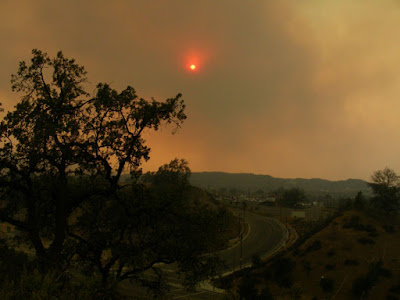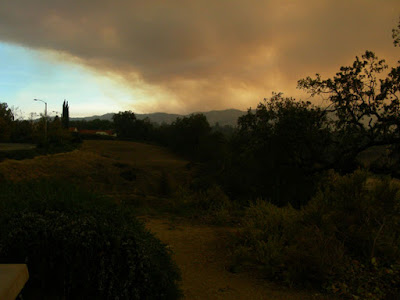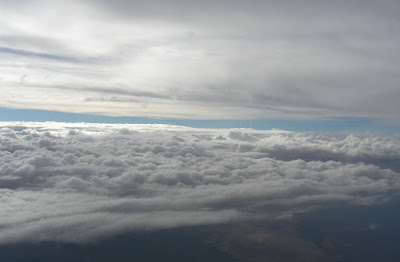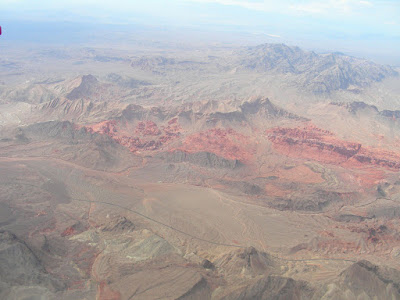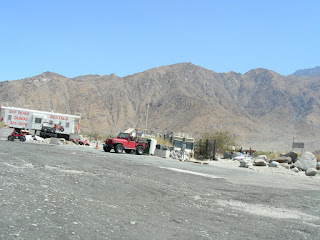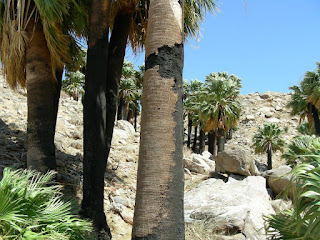I've had an eventful week, but I'm going to blog about something news-related. Last night there was a major accident that closed the 5 freeway at the Newhall Pass. Several people died in flames. Traffic was stopped on the freeway for upwards of 7 hours.
On Friday, I spent the day with a friend who visited me from New Hampshire. We toured around Los Angeles and saw the play "Avenue Q" in the Ahmanson Theatre. Then I dropped my friend off at her hotel on Wilshire Blvd. and headed north for home. That was around 10:30pm.
First of all, it was raining. This was the first rain we've had in many months, and traffic accidents always happen in L.A. during rainy nights, so I was prepared for some heavy traffic. I figured I'd be home by 11:30pm.
I needed to get to any northbound freeway in order to get to the 5 freeway. Most freeways of Los Angeles feed into the I-5, which runs through the center of the city and continues south to San Diego and Mexico, and north to San Francisco and other states. I drove over a bridge across the 110 freeway and saw how clogged it was, so I skipped it and headed towards the 170 Hollywood freeway. In my limited experience, the 170 moves fast.
I crossed Hollywood Blvd. and headed up Highland Ave. Traffic stopped. It inched along, and then it completely stopped. I sat at the same block for half an hour. I figured a concert must have just gotten out from the Hollywood Bowl, and decided that the 170 was a bad choice. So I turned around as soon as I was able, which involved a lot of manuevering and luck. I made my way through a warren of traffic-clogged alleys and finally back to Sunset Blvd., which was mostly empty. I decided I'd cross the city on surface streets and take the 405 freeway.
Around 11:30pm, I was on the 405 freeway. I passed a sigalert roadsign that said the 5 freeway was closed, and there was a detour at Balboa Blvd. (a two-lane street). I thought:
WTF?! The 5 freeway DOESN'T close. Impossible. It's a vital freeway to the city. The last time it closed was when the Northridge earthquake destroyed an overpass in the year 1994. As far as I knew, there was no reason for it to close. I drive it every weekend, very often on Friday or Saturday night, and I've never seen it with heavy traffic near midnight. The heavy traffic is reserved for rush hour...
I saw brake lights around a bend. A bunch of cars quickly exited at the nearest exit. I got into the exit lane, and figured I'd use the next exit if traffic turned out to be really slow.
It stopped. For 7 hours.
I was very fortunate, because I was only stuck for 2 and a half hours. I don't know what happened to the cars in the other lanes; I suspect that some of them were stuck there until dawn or later.
I had no entertainment except for radio and music. The guy in the car next to me had a reading light and was reading a book or magazine. I shifted my gear into park, and there it stayed. People were getting out of their cars and walking around in the rain, trying to see what was holding up traffic. I tuned in to the radio news stations.
The news claimed that the 5 freeway was closed, and so was the 14 freeway, and the 210 freeway. Balboa Rd. was hopelessly clogged. In other words, there was no way for anyone to get to the suburbs 15 minutes north of L.A. unless you took a loooooooooong detour of 3 or 4 hours. None of the channels could give an ETA of when the freeways would open. Every channel reported a different story of what the accident was. One report claimed that four big rigs had collided and caught on fire. Another report said it was fifteen trucks. Another said they were in a tunnel that was collapsing from the heat. But none of them explained why that would close an entire freeway of 6 lanes northbound and 6 lanes southbound, or why two other freeways were closed. I later learned that the explosions in the tunnel created a danger of road collapse. All of the surrounding freeways and surface streets near the accident were clogged enough to necessitate closure.
I listened to this news, and I considered taking an obscure mountain route home. The obscure road is known as "A Street" in Filmore, also known as route 23. It has a section of tall, sheer cliffs and hairpin turns. It's a dangerous road to take at night in the rain. This is mudslide country.
Even so, I had hours in which to ponder. The obscure route 23 is not common knowledge even to local residents. I'd be home in under two hours if I could exit and get on the 118 freeway towards Moorpark.
I happened to be parked near the next on-ramp. As I pondered, I watched cars drive up the ramp, pile up, and then drive down the ramp on by one, in reverse. It was like a parade.
Around 2:15am, a motorcycle cop wove between the parked cars and went to the on-ramp. He began directing cars to drive down the ramp. At long last, traffic was moving ... off the freeway. Even so, most people chose to stay. I guess they didn't want to lose their place in line, and they believed traffic would HAVE to move soon. Traffic accidents are statistically common in Los Angeles. Locals depend on the fact that accidents get cleaned up swiftly. Otherwise, we'd be stranded all the time. The city is too spread out for freeway closures.
When I exited the freeway, I had no idea it would remain closed for days. Like everyone else, I believed it would be open within a few hours; I just was unwilling to wait those hours.
I drove down the least clogged surface street until I was well away from the freeway. Then I stopped at a gas station for a bathroom break. While I bought a drink for the road, a man in white collar business attire walked up to the register and asked me if I knew what had happened on the 5 freeway. He'd been stuck there since 11pm. He lived in the same town as me, and was also trying to get home. I told him about the obscure mountain road, but I couldn't remember the street names necessary to give driving directions. He was distraught, because he had nowhere to stay. He bought a toothbrush and asked the gas station attendant for directions to the nearest motel.
I'm fortunate, because I have someone to stay with. I called up my boyfriend, Phil, and warned him that I might need to crash at his place for the night. Then I headed for the obscure mountain route.
As soon as I got onto the westbound 118 freeway, I saw a line of traffic on the eastbound side, all of them trying to get onto the 405 north, where I'd been parked for the last two hours. I finally pictured the scope of this traffic jam. The standstill went for miles and miles. These freeways all have 4 to 6 lanes. They can carry hundreds of thousands of fast-moving cars. If it had gotten to this state between 11pm and 2:30am, it would get much worse with the morning traffic.
If I turned back, I'd get stuck in the eastbound 118 traffic trying to get to the 405 north trying to get to the 5 north. Wow. But it wasn't too bad yet. In a few more minutes, it might be.
The rain became a downpour. I imagined myself navigating the hairpin turns on the edge of that cliff, with the road slick from dust and oil loosened by the season's first rain. The road might become impassable from a mudslide.
I turned around, and I made it to Phil's place by 3am. I'm grateful that I had a place to go. I kept thinking about all the cars still stuck there, and the exhausted man who had to get a motel room less than 15 minutes from his home.
In the morning, I watched the news to make sure the 5 freeway was open. It wasn't.
I got a horrible, frustrated feeling that's hard to convey here. I couldn't get home. I wanted a change of clothing, and I needed to do my laundry, and so forth ... and I couldn't. My home was less than 40 miles away, but it might as well have been in another state.
We researched detours. It turned out that the obscure mountain route 23 was being used by trucks bound for Los Angeles and San Diego. I shuddered to think of all those trucks on that cliff. I imagined them shoved sideways on the hairpin turns, or stuck in mud. The auto traffic was diverted to Calgrove Blvd. and the 14 freeway. Estimated travel time to my home: At least four hours.
I spent the day with Phil. He cheered me up, but I still had to face a long journey to get home. The drive usually takes me half an hour. Instead, I figured I'd go all the way around to Ventura County. That would be about three hours, if traffic stayed light.
I changed my mind mid-drive and headed for mountain route 23 after all. The radio news reported that southbound I-5 traffic was diverted that way, but they never mentioned northbound. I figured it was worth the risk, since traffic tends to be light around that time, and it wasn't raining.
What a pleasant surprise! I encountered no northbound traffic whatsoever. I began to think the 5 freeway was open again. Then I saw a long line of cars and trucks heading southbound over route 23. Now I'm left to wonder why northbound traffic wasn't diverted that way. I made it home in less than two hours.
The latest news is that the 5 freeway might be open as early as Tuesday. Until then, thousands of suburban commuters have no useful way to get to their jobs. All the residents of Los Angeles and San Diego who flocked to Northern California for the weekend will have a hard time getting home. All the trucks that deliver produce and goods to these major cities will have no good way to deliver them.
The 5 freeway closure had to happen, because that was a hell of a serious accident. But I think this is a warning that a valley with only a few routes in and out can become a trap. I hope something good will come from this disaster. Maybe whoever is in charge of Los Angeles infrastructure will add a few more roads through the mountain passes.


